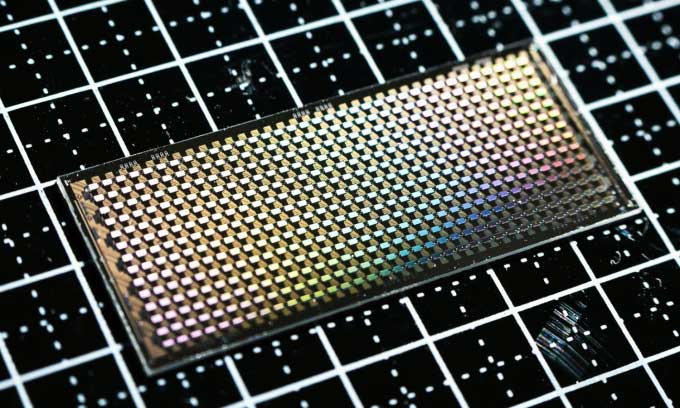China creates quantum computing chips that are 10 billion times faster than regular chips
Chinese scientists have developed a 504-qubit quantum computing chip to make it available to researchers worldwide via a new cloud computing platform.
The new chip called "Xiaohong" is the most powerful chip built by China to date and is designed to improve systems that manage the behavior and interactions of quantum bits or qubits in computers. Scientists hope the chip will help scale existing computers so they can handle more complex tasks.
"Xiaohong" was developed by scientists at the Center of Excellence for Quantum Information and Quantum Physics , part of the Chinese Academy of Sciences (CAS). Chinese quantum computing company QuantumCTek, which received the first "Xiaohong" chip , will reportedly work with China Telecom Quantum Group to integrate the 504-qubit chip into the new quantum computer.

China manufactures 504-qubit quantum computing chip. (Photo: Center of Excellence for Quantum Information and Quantum Physics).
The system will then be made available to researchers worldwide through a cloud computing platform developed by China Telecom Quantum Group .
Wang Zhen, deputy general manager of China Telecom Quantum Group, said that the new system will enable users in various fields to effectively conduct research on problems and algorithms of practical value. efficiency, while accelerating the application of quantum computing in real-life situations.
Xiaohong is designed to meet the performance standards of cloud computing platforms like those produced by IBM or AWS. But it is not intended to be a technical rival to cutting-edge American technology like the 1,121-qubit IBM Quantum Condor chip, said Gong Ming, a researcher at the Center of Excellence in Quantum Information and Quantum Physics. know.
Instead, scientists hope accessing "Xiaohong" via cloud computing will spur the development of large-scale quantum computing measurement and control systems (QCMCS).
Unbelievable speed
Quantum computers operate fundamentally differently from classical computers. Unlike classical bits, which can only be represented as 0 or 1, qubits can exist in multiple states simultaneously. This allows quantum computers to perform calculations in parallel and at speeds that are almost unimaginable if qubits are coupled together via quantum.
Meanwhile, QCMCS are components that play an important role in quantum computing - acting as a bridge connecting traditional computers with quantum computers. This connection allows the quantum computer to interpret commands received from the classical computing environment and manage the qubit state accordingly.
Although the 504-qubit Xiaohong chip is China's largest quantum chip to date, it is not the world's largest. The title currently belongs to Atom Computing, which announced its massive 1,125-qubit quantum computer in October 2023.
Notable previous Chinese contributions include the Jiuzhang 2.0 and Zuchongzhi 2.1 supercomputers . When China launched its quantum computer Jiuzhang in 2020, it claimed it was the fastest computer in the world - said to have surpassed Google's Sycamore supercomputer by 10 billion times.
- What is quantum computing and its importance to people?
- What are the Advantages of Quantum vs Edge Computing
- China successfully developed the world's first quantum computer
- Google and NASA developed computers 100 million times more powerful than conventional computers
- China moves closer to quantum chips by creating a new light source
- For the first time, scientists have successfully implemented quantum shifts between two chips
- How far has the quantum computer developed?
- For the first time, quantum computers have been proven to be more powerful than classical computers
- Microsoft successfully created a quantum state that is not found in nature
- Google makes quantum computers, a billion times stronger than the current most powerful supercomputers
- Successfully fabricated quantum circuit breaker
- The absolute advantage of light quantum chips: Shorten 9,000 years of computation to 36 millionths of a second
 The US company is about to build a supersonic passenger plane of 6,000km / h
The US company is about to build a supersonic passenger plane of 6,000km / h Japan develops avatar robot as in fiction film
Japan develops avatar robot as in fiction film Australia tested the world's first mango picking robot
Australia tested the world's first mango picking robot America develops technology to separate water from animal waste
America develops technology to separate water from animal waste The most powerful computer in the world
The most powerful computer in the world  China produces -273 degree C quantum computer refrigerator
China produces -273 degree C quantum computer refrigerator  The Secret Behind Quantum Entanglement: Have Aliens Really Visited Earth?
The Secret Behind Quantum Entanglement: Have Aliens Really Visited Earth?  The greatest contradiction of contemporary physics, Albert Einstein spent half his life but could not solve it
The greatest contradiction of contemporary physics, Albert Einstein spent half his life but could not solve it  China has successfully built the first quantum engine using quantum entanglement.
China has successfully built the first quantum engine using quantum entanglement.  China 'unveils' 504 qubit superconducting quantum computer
China 'unveils' 504 qubit superconducting quantum computer 